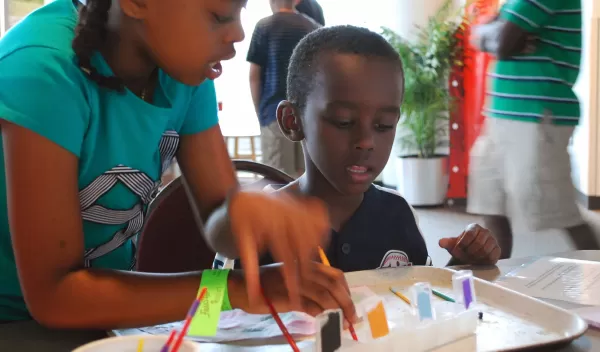
Learning through making
In the Tinkering Studio at the Exploratorium in San Francisco, a group of young people is making tiaras--light-up tiaras. Using copper wire, a soldering iron, batteries and LED lights, they use trial and error to build the kind of design they want. In the process, they start to figure something out. If you want all your lights to glow, you have to create a parallel circuit. A series circuit will not provide enough voltage.
"This is different from the way I was taught in school," says Exploratorium Project Director Karen Wilkinson. "Adding this tinkerable element is powerful; the outcome isn't entirely known at the beginning, and this is a pretty critical part of learning. "
Tinkering is an important element of the "maker movement," a technology-influenced do-it-yourself (DIY) community that, since the early 2000s, has tapped into people's desire to create things in a hands-on way. Recognition of making as a means to innovation and entrepreneurship is getting a boost this week with the first White House Maker Faire on June 18.
The National Science Foundation (NSF) has long supported making as a pathway to STEM learning outside of school. In 2005, NSF funded the Playful Invention and Exploration (PIE) Institute to increase the capacity of museum educators and exhibitors to design and implement technology-integrated inquiry activities for the public.
Since that time, the PIE network--a community of educators from science museums--has worked to learn what it takes to engage museum visitors in making activities and to effectively offer virtual visitors ideas for making, and opportunities to share their creations.
"There's no question that these kinds of activities are creative and can introduce young people to designing and building in a hands-on way," said NSF Assistant Director Joan Ferrini-Mundy, who leads the Education and Human Resources directorate. "What we're most interested in at NSF is how these experiences affect STEM learning: How can making be used most effectively to help students of all backgrounds learn science, technology, engineering and mathematics?
The Exploratorium's in-house visitor research group reports that time spent on tinkering activities is much longer than that spent on traditional museum exhibits. Stanford researchers are working with the Tinkering Studio on a new NSF-funded research study focused on what happens, learning-wise, after tinkerers leave the museum. Groups of students are coming to the museum to do hands-on activities, then being followed back to their classrooms to see how the experience affects their learning. The results are expected to help guide future tinkering activities.
At the Science Museum of Minnesota, every Saturday from noon to 4 p.m., the whole museum becomes a makerspace, with activities ranging from creating objects using simple materials like duct tape, to constructing a sound synthesizer, to building and operating simple robots.
Keith Braafladt, director of the museum's Learning Technologies Center, has developed activities that introduce museum visitors to the Arduino, a robotics-based construction kit.
"We've been trying to think about emerging technology, but making it transparent," he says. "People can learn a little programming as they create something that moves and lights up as they interact with it."
In sponsoring making activities, the museum depends on a dedicated group of volunteers who support the activities while allowing the makers to discover and problem-solve at their own pace.
The museum's next challenge is to broaden the participation of community members in making, particularly given that the practices of making are common in diverse communities. A new NSF-funded project involves working with the local community to see how groups underrepresented in the maker movement can become engaged in making at the museum. The goal of this research project is to attract families from Native American, African-American, Hispanic, Hmong and Somali communities, among others in the vicinity of the museum, and ultimately engage them in meaningful STEM learning.
The community surrounding the museum is also the focus of a new NSF-supported project at the New York Hall of Science. The Innovation Institute: From Problem to Product (I2) takes young people through the entire process of inventing a device, software or other technology.
"The participants in the Innovation Institute are encouraged to look with new eyes to create something of economic, social and environmental value to the community," says Principal Investigator Ellen Wahl.
The project stresses STEM content and process in engineering, as well as entrepreneurship, design research and innovation. It draws on the fact that the Queens, N.Y., neighborhood where the museum is located has immigrant communities made up of many small-business entrepreneurs.
"Immigrants have fueled innovation in this nation," says Wahl, "and the end goal is to find out what it takes to broaden participation in the science and engineering workforce."
The Innovation Institute primarily targets teams of high-school students from the area. The high-school teams have 15 months to develop their designs, which are guided by experts in engineering and entrepreneurship. Their completed prototypes will be critiqued by a technical expert committee comprised of museum trustees who are CEOs, CIOs, and CTOs of major technology corporations. High-school team members also staff the floor of the museum and share their knowledge of the engineering process with middle-school students from the area.
Today, making is being experienced by more and more people, with activities to educate and inspire young and old. Museums are finding new and creative ways to make learning a part of making activities and to reach broader segments of the community.
Will future scientists, engineers and innovators credit their making experiences as a major influence on their chosen field? NSF-supported research helps explore this question. Many in the maker movement are betting, "Yes."


